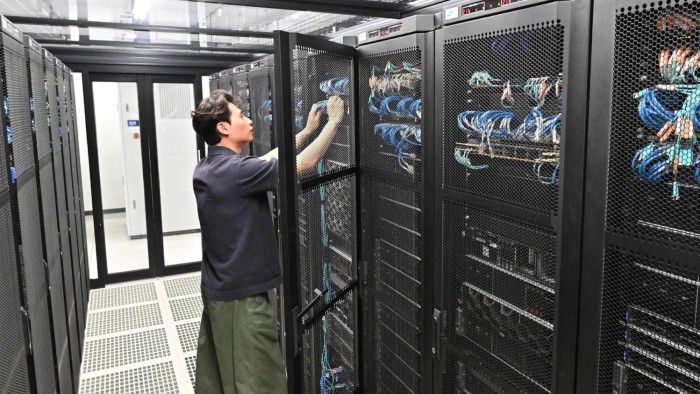Spending time in a warm, noisy building full of servers, routers, and storage devices might not be everyone’s idea of a fun day. It doesn’t seem like an attractive investment opportunity, much less.
But these humble physical assets, known as data centers, are the heart of emerging technologies like the internet, cloud services, and AI. As internet usage and AI adoption increases, so does the need for powerful data centers. In fact, ABI Research predicts that the number of public data centers worldwide could reach approximately 5,700 by the end of the year and exceed 8,400 by 2030.
This makes them an attractive physical asset for high-net-worth individuals and investors looking to capitalize on technological trends and reap high returns. However, investments involve considerable risks, including significant environmental impact, cumbersome procedural delays, and high construction and operating costs.
Still, data centers have significant market potential. The industry is expected to be worth $416 billion this year and reach $624 billion by 2029, according to research firm Statista.
Vicente Vento, founder and CEO of Digital Transformation Capital Partners, an investment management business spun out from Deutsche Telekom in 2015, said the expansion of cloud services, increased digitization and data consumption trends , says the AI boom is “a major driver of the industries that are shaping the world.” The backbone of digital services.”
David Bloom, founder and chief executive officer of IT-focused investment firm Goldacre, said “continued demand” for cloud services and “increased adoption” of large data centers around the world are driving data It agrees that the center has the potential to deliver “significant” returns to investors.
According to analyst Canalys, global cloud computing spending exceeded $78.2 billion in the second quarter of 2024, an increase of 19% year-over-year. This means there is an urgent need for more data centers. Data center capacity in Europe’s core markets is expected to grow by 16% this year, according to a report from real estate services firm JLL.
Bloom said: “Big funds like Blackstone are putting a lot of money into this space, with plans to spend $1 billion[in the UK]to make the most of the potential for a surge in demand for AI. We’ve seen evidence of this through Google’s work.”
Rajesh Senik, partner at KPMG, said the data center industry can provide investors with long-term and stable investment returns thanks to consistent and steady growth. Choosing a data center in the right location is essential, he said, as data center investments typically yield between 5 and 12 percent and “require sufficient reliable power supply.” It is said that
He encourages investors to consider regions that offer access to renewable energy sources such as hydroelectricity, wind power, and solar power to reduce both costs and environmental impact.
Sennick said that for many investors, hyperscale data centers (larger, scalable facilities that serve businesses and organizations with a wide range of IT needs) offer “high visibility and revenue from long-term contracts.” He said it would be the best investment option because of the benefits it offers. “It also allows us to put a lot of capital into markets that have the potential for sustained growth,” he says. “Investors can target returns of up to 20% on their potential investments given the right opportunity.”
Despite the potential for significant yields, investing in data centers can come with risks, Wendt cautions. He said that given the complex nature of data centers, particularly with regard to their design and components, investors should ideally have some industry knowledge or a good understanding of these assets before investing. says.
As net-zero goals rise to the top of companies’ agendas, investors need to consider the negative impact data centers have on the environment. A 2022 study by climate data company Climatiq found that data centers account for a larger share of global CO₂ emissions (2.5 percent) than aviation (2.4 percent).
James Igoe, head of investment management firm Redmayne Bentley’s Manchester office, expects this energy consumption to increase over the next few years, based on existing forecasts.
Investors looking to advance their data center investments can take several steps, balancing yield and risk. Igoe said the company is approaching private infrastructure funds with expertise in this area, including Blackstone and KKR. It should be noted that these funds typically expect a minimum investment of £10 million per deal.
Another option for non-institutional investors is to invest in data centers through real estate investment trusts (REITs) such as Equinix, which recently reported a 7% year-over-year revenue increase in Q2 2024. Recorded. “Data center-focused REITs have performed well over the past five years given the sector’s demand and future growth potential,” Igoe said.
Investors who are deterred by the risks of investing in data centers but want to take full advantage of the market’s potential may instead invest in critical components of these assets such as processors, servers, and cooling systems. You can invest in companies that manufacture, said managing partner Jonathan Frick. consulting firm Bain & Company;
AI systems that require data centers also have the potential to benefit tech-savvy investors. “Beyond infrastructure, the application layer of AI is growing even more rapidly, creating opportunities for AI-driven software and services. There are also technical risks involved,” says Frick.


